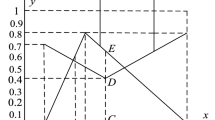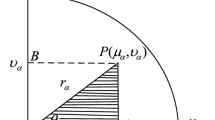Abstract
Pythagorean fuzzy number (PFN) is not only an extension of traditional intuitionistic fuzzy number (IFN), but also can deal with the decision-making problem of multi-attribute information in a wider range. In recent years, it has been rapidly developed and popularized in the field of decision science. Firstly, it is pointed out that there are some defects in the existing score function and ranking criteria of PFNs through counter examples, and the main causes of these defects are analyzed according to the geometric method. Secondly, IFNs are unified into the Pythagorean fuzzy environment, the new unified score function and geometric ranking criterion of IFNs and PFNs are proposed by the corresponding upper curved trapezoidal area and hesitation factor, and then the rationality of geometric ranking method and some basic properties of the score function are studied. Finally, the comparison of other ranking methods shows that the proposed method only needs a score function and its own hesitation to rank all PFNs uniformly, especially the accurate comparisons among equivalent PFNs are realized. This not only overcomes the contradiction and confusion caused by the respective ranking of traditional IFNs and PFNs, but also provides a theoretical basis for further expanding the fuzzy decision-making method of Pythagorean fuzzy sets.





Similar content being viewed by others
References
Atanassov, K.: Intuitionistic fuzzy sets. Fuzzy Sets Syst. 20(1), 87–96 (1986)
Chen, S.M., Tan, J.M.: Handling multicriteria fuzzy decision-making problems based on vague set theory. Fuzzy Sets Syst. 67(2), 163–172 (1994)
Hong, D.H., Choi, C.H.: Multicriteria fuzzy decision-making problems based on vague set theory. Fuzzy Sets Syst. 114(1), 103–113 (2000)
Xu, Z.S.: Some similarity measures of intuitionistic fuzzy sets and their applications to multiple attribute decision making. Fuzzy Optim. Decis. Making 6, 109–121 (2007)
Pedrycz, W., Song, M.L.: Analytic hierarchy process (AHP) in group decision making and its optimization with an allocation of information granularity. IEEE Trans. Fuzzy Syst. 19, 527–539 (2011)
Chen, S.M., Cheng, S.H., Lan, T.C.: Multicriteria decision making based on the TOPSIS method and similarity measures between intuitionistic fuzzy values. Inf. Sci. 367–368, 279–295 (2016)
Yager, R.R., Abbasov, A.M.: Pythagorean membeship grades, complex numbers and decision making. Int. J. Intell. Syst. 28, 436–452 (2013)
Yager, R.R.: Pythagorean membership grades in multicriteria decision making. IEEE Trans. Fuzzy Syst. 22(4), 958–965 (2014)
Zhang, X.L., Xu, Z.S.: Extension of TOPSIS to multiple criteria decision making with Pythagorean fuzzy sets. Int. J. Intell. Syst. 29(12), 1061–1078 (2014)
Peng, X.D., Yang, Y.: Some results for Pythagorean fuzzy sets. Int. J. Intell. Syst. 30(11), 1133–1160 (2015)
Ren, P.J., Xu, Z.S., Gou, X.J.: Pythagorean fuzzy TODIM approach to multi-criteria decision making. Appl. Soft Comput. 42(2), 246–259 (2016)
Zhang, X.L.: Multicriteria pythagorean fuzzy decision analysis: a hierarchical QUALIFLEX approach with the closeness index-based ranking methods. Inf. Sci. 33(1), 104–124 (2016)
Wan, S.P., Jin, Z., Wang, F., et al.: A new ranking method for Pythagorean fuzzy numbers. 12th International Conference on Intelligent Systems and Knowledge Engineering, 2017, Nov 24–26, Nanjing, China, pp. 1–6.
Peng, X.D., Dai, J.: Approaches to Pythagorean fuzzy stochastic multi-criteria decision making based on prospect theory and regret theory with new distance measure and score function. Int. J. Intell. Syst. 32(1), 1187–1214 (2017)
Li, D.Q., Zeng, W.Y.: Distance measure of Pythagorean fuzzy sets. Int. J. Intell. Syst. 33(2), 348–361 (2018)
Peng, X.D.: Algorithm for pythagorean fuzzy multi-criteria decision making based on WDBA with new score function. Fund. Inform. 165(2), 99–137 (2019)
Huang, C., Lin, M.W., Xu, Z.S.: Pythagorean fuzzy MULTIMOORA method based on distance measure and score function: its application in multicriteria decision making process. Knowl. Inf. Syst. 62(11), 4373–4406 (2020)
Garg, H.: A new improved score function of an interval-valued Pythagorean fuzzy set based TOPSIS method. Int. J. Uncertain Quantif. 7(5), 463–474 (2017)
Garg, H.: A novel improved accuracy function for interval valued Pythagorean fuzzy sets and its applications in decision making process. Int. J. Intell. Syst. 31(12), 1247–1260 (2017)
Garg, H.: A linear programming method based on an improved score function for interval-valued Pythagorean fuzzy numbers and its application to decision-making. Int. J. Uncertainty Fuzz. Knowl.-Based Syst. 26(1), 67–80 (2018)
Wan, S.P., Jin, Z., Dong, J.Y.: Pythagorean fuzzy mathematical programming method for multi-attribute group decision making with Pythagorean fuzzy truth degrees. Knowl. Inf. Syst. 55(2), 437–466 (2018)
Peng, X.D., Dai, J., Garg, H.: Exponential operation and aggregation operator for q-rung orthopair fuzzy set and their decision-making method with a new score function. Int. J. Intell. Syst. 33(11), 2255–2282 (2018)
Peng, X.D., Ma, X.L.: Pythagorean fuzzy multi-criteria decision making method based on CODAS with new score function. J. Intell. Fuzzy Syst. 38(3), 3307–3318 (2020)
Rahman, K., Abdullah, S., Ahmad, R.: Pythagorean fuzzy Einstein geometric operators and their application to multiple attribute decision making. J. Intell. Fuzzy Syst. 33, 635–647 (2017)
Ullah, K., Mahmood, A., Ali, Z., et al.: On some distance measures of complex Pythagorean fuzzy sets and their applications in pattern recognition. Complex Intell. Syst. 6(1), 15–27 (2020)
Firozja, M.A., Agheli, B., Jamkhaneh, E.B.: A new similarity measure for Pythagorean fuzzy sets. Complex Intell. Syst. 6(1), 67–74 (2020)
Khan, M.S.A., Abdullah, S., Ali, M.Y., et al.: Extension of TOPSIS method based on Choquet integral under interval-valued Pythagorean fuzzy environment. J. Intell. Fuzzy Syst. 34, 267–282 (2018)
Wang, G.J., Tao, Y.J., Li, Y.H.: TOPSIS evaluation system of logistics transportation based on an ordered representation of the polygonal fuzzy set. Int. J. Fuzzy Syst. 22(5), 1565–1581 (2020)
Li, X.P., Tao, Y.J., Li, Y.H.: Decision making method for evaluating logistics companies based on the ordered representation of the polygonal fuzziness. J. Intell. Fuzzy Syst. 9(3), 3151–3166 (2020)
Li, X.P., Li, Y.H., Tao, Y.J.: Representation and aggregation of multi-source information of modern smart cities based on the intuitionistic polygonal fuzzy set. Int. J. Fuzzy Syst. 23(4), 967–983 (2021)
Wang, L., Wang, H.: An integrated qualitative group decision-making method for assessing health-care waste treatment technologies based on linguistic terms with weakened hedges. Appl. Soft Comput. (2022). https://doi.org/10.1016/j.asoc.2022.108435
Sun, G., Li, X.P., Chen, D.G.: Ranking defects and solving countermeasures for Pythagorean fuzzy sets with hesitant degree. Int. J. Mach. Learn. Cybern. 13(5), 1265–1281 (2022)
Sun, G., Wang, M.X., Li, X.P.: Centroid coordinate ranking of Pythagorean fuzzy numbers and its application in group decision making. Cogn. Comput. 14(2), 602–623 (2022)
Funding
This work has been supported by National Natural Science Foundation of China (Grant No. 61463019/61374009), and Natural Science Foundation of Hunan Province (Grant No. 2019JJ40062).
Author information
Authors and Affiliations
Corresponding authors
Ethics declarations
Conflict of interest
The authors declare that they have no conflict of interest.
Ethical Approval
This article does not contain any studies with human participants or animals performed by any of the authors.
Informed consent
The informed consent was obtained from all individual participants included in the study.
Rights and permissions
About this article
Cite this article
Li, Y., Sun, G. & Li, X. Geometric Ranking of Pythagorean Fuzzy Numbers Based on Upper Curved Trapezoidal Area Characterization Score Function. Int. J. Fuzzy Syst. 24, 3564–3583 (2022). https://doi.org/10.1007/s40815-022-01359-z
Received:
Revised:
Accepted:
Published:
Issue Date:
DOI: https://doi.org/10.1007/s40815-022-01359-z




